Architectural Stone Veneers: Authentic and Appropriate Technology
Hand-molded stone veneer provides lightweight alternatives for natural finishes.
![]() Continuing Education
Continuing Education
Use the following learning objectives to focus your study while reading this month’s Continuing Education article.
Learning Objectives - After reading this article, you will be able to:
- Balance the requirement for a natural material with one that has environmental benefits such as reduced transportation costs and recycled material content.
- Add to the thermal mass of the envelope and design for energy efficiency by using stone veneers and evaluate techniques used to achieve the aesthetic of authentic stone surfaces.
- Design for the long life of a building by using a product which is durable and easy to maintain.
- Choose a product that can be manufactured locally and explain key technical information about water management, evaluation reports, testing and other factors that might effect performance quality.
- Design using a stone veneer product that reflects nature, adding to human comfort and sense of well-being for both interior and exterior surfaces, without using a nonrenewable resource.
The advantage of building veneers is that the designer can develop an environmental skin for the entire building facade while responding to varied aesthetic approaches as a separate system. Design professionals might choose a cladding for the facade of any building to make it appear either old or new but provide a high-tech green wall enclosure to meet strict green building code standards. The rules have changed for those who want the best of both worlds: aesthetic appearance along with environmental benefits. Manufactured stone veneer is an alternative material choice that provides a natural surface while using an affordable and appropriate green technology. Lightweight architectural stone veneer provides an invisible, measurable difference in performance and aesthetic values.
Cognitive research and current behavioral studies have demonstrated that humans respond favorably to the complex forms and colors in nature. To the general public, stone buildings represent permanence, quality and beauty as well as a nod to nature. As an alternative to stone, designers who are meeting tight budgets and looking for environmentally beneficial materials are choosing lightweight stone veneer finishes. “Manufactured stone is growing in popularity as an alternative to natural stone because of its believability, affordability and the sincere warmth and texture it can bring to any space indoors and out,” says Brent Spann, VP of Marketing for Eldorado Stone. “When you use natural stone, you can only use what's available and when that vein of stone color is gone, it's gone in nature.”
One-third the weight of natural stone and half the cost of natural stone installed, the environmental benefits of this product include contributions to the thermal mass of the envelope, as well as a large percentage of pre- and post-recycled content. There is also the local availability of this product that reduces transportation costs. This product is a response to the need for alternative facade materials that provide the complexity and design appeal of natural finishes without the environmental costs of mining and transportation.
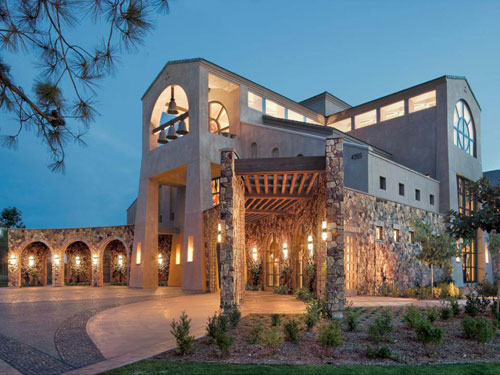 |
Photo courtesy of Eldorado Stone St. Theresa of Carmel Catholic Church in San Diego, California, designed by Hyndman & Hyndman Architecture & Interiors, is clad in a manufactured stone veneer to provide an authentic natural finish to the facade. |
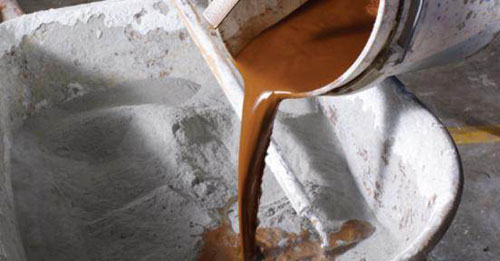 |
Photo courtesy of Eldorado Stone Molds are created from selected stones representing regional and authentic stone formations. |
Stone veneer is a unique product that is both handmade and mass-produced as well as hand-placed by masons on a building site. Some stone veneers can also be specified as a panel but each panel has the appearance of a hand-placed finish. Each flat of stones is part of a stone profile that is based on regional rock formations. Individual molds replicate the unique characteristics of real stones that have been selected by researchers and collectors from geologic formations. The individual pieces are formed in molds that have the shapes and hollows of an actual stone. The base color is blended and mineral oxides are applied to provide an authentic appearance of a specific geologic formation. “The authenticity and natural look of the stone is what will attract a customer,” Spann says. “The ability to also create custom colors and blends by taking some stones from different profiles and mixing them gives architects the creative control they love. And a manufactured stone allows you to match up with existing stone even many years later.”
Confronted by the cost of transportation, environmental degradation and difficult, costly installations, designers seeking to use stone as a means to bring natural finishes and the nuances of natural colors into their projects can choose a lightweight and more affordable alternative with an authentic natural finish. Lightweight stone veneer is a cementitious product that can be used by designers in many creative applications. Used as an exterior and interior finish on libraries, churches, schools and hotels, this material has proven to be versatile as it is a good environmental choice. Designers have incorporated stone veneer in projects that have both a traditional as well as modern aesthetic. Stone veneer is used in residential projects as well as in commercial settings and excels as a surface material for retaining walls.
TEMECULA LIBRARY – SELECTING AN APPROPRIATE TECHNOLOGY
The 34,000 sf library was completed in 2006 and was designed as a “place to learn; a place to explore; a place to discover old traditions and new opportunities.”2 Choosing a manufactured stone veneer as a finish material allowed the architects to keep within budget and use the lightweight properties of this veneer as a design feature. The dramatic glass entry is contrasted by the stone veneer cladding, creating a metaphor between the old and the new, celebrating the culture and future of the community in this project. According to Craig Whitridge, LEED AP, BD +C, the project architect at LPA Inc., “The key to making the finished product look like real stone is having an installer that understands the material and knows that it cannot simply be taken out of the box and placed on the wall like it was a box of ceramic tile, where all of the pieces are uniform and the same. The installation of manufactured stone veneer requires an installer with an artistic flair and the ability to sort through the pieces and assemble them in a way that achieves a natural look. Otherwise, the finished product tends to look like a layer cake.” Through careful installation and design, Temecula Library is an example of how this product can make a statement that reflects the environmental values of a community. |
|||||
Common Wall Substrates
Manufactured stone veneer can be applied to most common wall substrates – concrete masonry units (CMU), poured-in-place concrete walls, metal studs, metal panels, wood sheathing, open stud framing as well as rigid insulation. This section illustrates the appropriate application of stone veneer onto prepared scratch coat surfaces. The wall diagrams are to be used as reference only as all substrate construction should be designed to meet prevailing local building codes. The following is a brief review of some of the technical requirements for each substrate material and wall system.
Concrete
Stone veneer can be applied to clean, unpainted CMU block surfaces. It can also be applied over horizontally scored scratch coat. The installer should ensure a clean surface by spraying water on the block to see if the water beads. If so, additional treatment such as sandblasting or powerwashing, may be required for installation. If the CMU cannot be cleaned properly, metal lath may need to be installed using concrete nails or screws and a scratch coat applied to the lath before placing the veneer. The stone veneer is hand placed in a mortar setting bed by the installer.
A common use of stone veneer is to add it to the face of a retaining wall above the ground plane. Below-grade installations can lead to efflorescence, spalling and discoloration from minerals in the soil. For installations at grade, sealing the stone will minimize the potential for stains. Retaining walls should be designed and engineered for the environment. Dependent on the climate, the design professional will specify the proper mortar and cement mixtures to resist freeze and thaw constraints. Common practices for detailing retaining walls include the protection of surface water into the system by wall caps that extend beyond the wall edges from 1 in. to 2 in. minimum. This applies to any retaining wall with a stone veneer surface as well. Typically, the side of the wall that faces the earth is coated with a bitumen surface, and soil engineers will specify drainage materials, piping and/or a drainage mat to reduce the pressure on the wall from moisture accumulation.
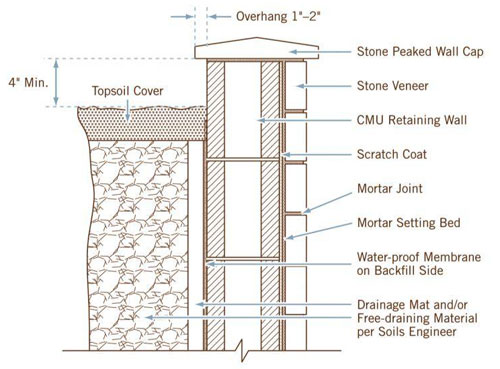 |
Image courtesy of Eldorado Stone Typical retaining wall detail. |
The design of the wall system should also include the planning for the irrigation system that may be designed later by the landscape architect or engineer. Stone veneer should never be used below water level. Landscape architects should consider using drip water systems around stone surfaces and avoid any prolonged irrigation spray of water. All irrigation water should be directed away from stone surfaces.
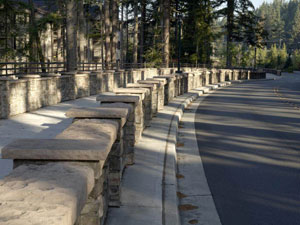 |
Photo courtesy of Eldorado Stone Architectural stone veneer can be used in parks, along roadsides and as part of a nature trail. |
To prepare the surface of a concrete poured-in-place wall, the installer will sand blast or powerwash the wall until it has a sandpaper-like texture. Applying a metal lath provides the most trouble-free installation on poured-in-place walls but using a primer (dash-bond coat) may increase bonding for applications without metal lath. When installing a metal lath, the designer should specify a maximum of 6-in. x 16-in. spacing between fasteners.
Many big-box stores use stone veneer surfaces over poured-in-place walls. The veneer usually is assembled and manufactured on panels rather than hand placed on the site for this application.
Some commercial properties are combining manufactured stone veneer with a stucco finish. There are two important requirements to be met when using stone veneer with stucco. Stone veneer can be installed over clean stucco surfaces that meet ASTM C926.
This standard covers the requirements for the application of the full thickness of Portland cement-based plaster for exterior stucco. If applying stone veneer over stucco, the design professional must verify with the mortar manufacturer that a 50 psi shear bond strength can be achieved over the surface to prevent cracking.
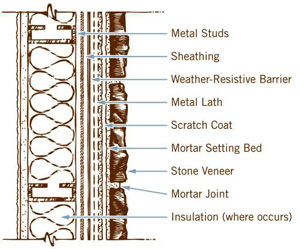 |
Photo courtesy of Eldorado Stone Typical wall section of stone veneer applied over metal studs. |
Metal
Metal stud construction is one of the most common construction types for commercial applications. Stone veneers applied over metal studs with no sheathing use corrosion-resistant self-tapping screws with a 7/16-in. head that provides a 3/8-in. minimum penetration beyond the metal surface. For installation over metal studs with sheathing, be sure to penetrate the inside metal surface by 3/8 in.
Stone veneer can also be applied over metal panels. Metal wall panels must provide a firm support and be a min. No. 18 gauge galvanized steel with a min. base-metal thickness of .0478 in. Attach the metal lath using self-tapping screws spaced 12 in. horizontally and 6 in. vertically. The scratch coat must be a minimum of 1/2 in. thick and be allowed to cure for at least 48 hours before installing veneer.
Wood
Commonly used in residential construction, apply stone veneer over wood sheathing or open stud framing by using a corrosion-resistant metal lath, a scratch coat and a mortar setting bed upon which the thin veneer is placed. The installer should use either a 2.5-lb. or a 3.4-lb. self-furred lath. Metal lath sheets should be overlapped at least 1 in. with the end pieces overlapping by a minimum of 2 in. Wrap lath a minimum of 16 in. around all corners. Stone veneer can also be applied over rigid insulation.
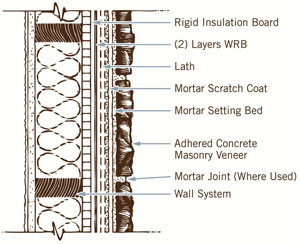 |
Photo courtesy of Eldorado Stone |
Insulating Concrete Formwork (ICF)
One of the newest and highly energy-efficient building systems being used in a variety of large-scale multistoried commercial buildings is insulating concrete formwork or ICFs. This product is made from hollow blocks made of insulation or foam formwork into which concrete is poured. Cladding is adhered with fasteners and manufacturers will provide assistance as to the recommended installation systems for their individual product. If the support brackets cannot support the weight of the veneer system, the installer can attach the lath through the ICF panels directly to the concrete cores. This product is often used in cold climates and for large mixed-use complexes and hotels.
Installation Basics
In general, all veneers should be applied to structurally sound surfaces and meet all local building codes. A manufacturer will provide specific application requirements for their products. The design professional should verify that proper testing has been conducted of any product and the appropriate evaluation reports obtained as to claims of environmental benefits, such as the recycled content of materials, as well as the validity of material claims.
There is an art to stone masonry, and the craft of choosing the right piece of stone and the type of grout bond is the same with the laying of stone veneer. Mortar, the bonding material that is made of cement or lime, sand and water and is used to bind stone veneer into place as it hardens, is chosen by type for its hardness. Premixed type N or S mortar is used to adhere stone veneer in place. Type N mortar is typically selected for exterior above-grade walls. Mortar must meet or exceed ASTM C270. This ASTM standard measures the compressive strength of mortar tested under laboratory conditions. The standard sets criteria for air content, compressive strength, bonding, amount of Portland cement and lime, among other elements. Mortar is applied as a scratch coat over lath to provide a good bonding surface for the stone veneer. The scratch coat should be scored horizontally with a notched trowel to provide proper support for stone placement.
 |
Photo courtesy of Eldorado Stone Proper preparation and application of mortar to backside of stone veneer. |
Grout color hue and the finished joint technique significantly enhance the appearance and authenticity of stonewalls. Choosing a grout that is the same color as the stonewall is usually done in more traditional designs. This type of application will create the visual appearance of a solid plane. By changing the color of the grout, the designer highlights the individual stones. There are three major types of grout techniques, all of which are common to a typical brick mason.
-
Dry stack joints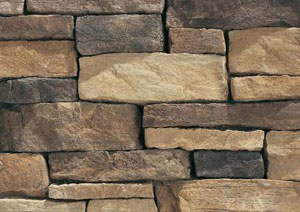
Photo courtesy of Eldorado Stone
Example of a dry stack joint.
- Standard joints
- Overgrout joints
A dry stack joint is the placement of each veneer piece on top of the scratch coat with virtually no joint. Specifying a colored setting bed mortar to match the stone veneer color hue will blend any exposed areas and make them disappear. Standard grout joints are achieved by laying each stone roughly one-finger width apart. When laying a chimney with a stone veneer, the interlocking pieces can create interesting patterns as some stones may be laid vertically as well as horizontally. The semi-dry mortar is later “raked” to achieve a consistent depth between the stones. A raked mortar joint creates a shadow profile along each stone and highlights the character of these unique pieces. Commonly used to create a sense of rustic or “old world” surfaces, an overgrout joint overlaps the face of the veneer, widening the joints and making them very irregular by design.
Transition Details
All transition details should be carefully considered or supervised as the solutions to these fine details present the opportunities to create depth, dimension and authenticity in interior and exterior walls. Transition areas include corners, grade, windows, doors, chimneys and often in commercial properties, signs.
Corners
In order to emulate a solid wall installation, stone should appear to interlock. The installer should avoid a straight grout joint creating vertical line along a wall. For an interior corner, alternate the stone returning to the wall from wall to wall. An experienced installer will be able to execute an interior or exterior corner to create an authentic appearance of a stonewall. Some designers may choose to vary the colors of the stone at the corners to create the appearance of corner quoins, a traditional detail highlighting stone at corners or at the foundation area of a building.
At Grade
Building code officials should approve any installations where stone will be installed to grade. Most building codes require specific moisture barriers and/or insulation to be applied as part of a wall system at grade. There are also requirements for how close to grade a veneer product can be placed. A typical installation will require the veneer to be terminated a minimum of 4 in. above the earth surface and 2 in. above any paved surface. In general, corrosion-resistant flashing must be installed around all penetrations and terminations of veneer application. Flashing should be applied in accordance to local building requirements.
Arts and Crafts Designs at Montage Resort
During the heyday of the arts and crafts movement in America, a young English emigrant—an architect and painter—discovered the town of Laguna Beach. His sketches and paintings drew numerous artists and architects to settle in this picturesque seaside village. Drawing from the historic arts and crafts character of the site, the developers of the Montage Resort, in Laguna Beach, chose to replicate this arts and crafts style in the design of the resort. The buildings are constructed of wood and manufactured stone veneer, highly detailed to convey the rich traditions of this 19th century English style architecture. Careful attention to detail included the use of decorative stone surrounds at walls, chimneys, doors and windows. Each of these elements adds to the overall design authenticity of the resort.
| |||||||
Signs
The weight of the sign as well as the engineering of any attachments to stone veneer must be carefully considered. Some general guidelines for adhering signs with adhesives may be an option for a lightweight sign. After the wall is constructed and the stone veneer attached to the substrate in the appropriate fashion, signs, letters, small surfaces or logos can be adhered to the veneer as long as the combined weight of the sign and veneer does not exceed 15 p.s.f. In areas with recorded higher wind speeds, there may be additional requirements to document adhesive strength and compatibility with the wall system.
Larger signs can be attached to the framing by engineering an anchoring system. It is important to assure that there is a self-sealing waterproof membrane, a minimum of 12 in. square at each penetration, to avoid moisture problems. All signs should meet the building, planning and zoning codes.
Special Cases
Height Restrictions
With a surge of multifamily mixed-use projects, hotels and resorts with client design preference for a rustic, natural feel, there are many taller buildings clad in stone veneer. Designers should know that veneer attached to wood backing or sheathing is limited to 30 ft. above grade. For installation above 30 ft., consult with your local building code official or structural engineer regarding additional structural requirements.
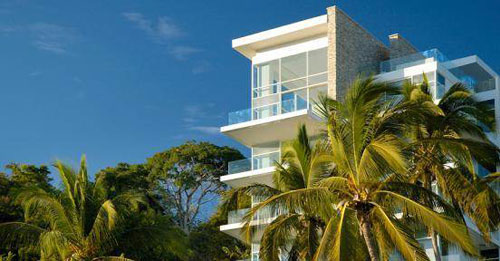 |
Photo courtesy of Eldorado Stone This multistoried hotel at the Bahlay Resort in Acapulco, Mexico, is clad with manufactured stone veneer. |
Expansion Joints
The placement of expansion joints adds one more layer of detail to any elevation or facade. Expansion joints allow movement in the facade, and these joints should not be spanned with stone veneer as this will lead to cracking. As part of preliminary design development, the architect will consult with an engineer on expansion joint requirements to enhance the design of the surface by careful placement of this key structural element.
According to a paper published in 2011 by the Masonry Institute, there does not seem to be a need for the installation of control joints based on aesthetic appearance alone in architectural veneer masonry construction. In comparison to stucco, this consultant concludes that it is unlikely that there will be water penetrating the lath behind the veneer. The “built-in” control joints (grout joints or dry stack stone joints) provide for expansion or contraction movement. Any cracking that may be experienced is accommodated across several grout joints, thereby allowing a distribution of the separation. Furthermore, each separation is virtually invisible, since these spaces occur at the stone-mortar interface. Where there are expansion joints in a building, “it is appropriate to install an expansion joint in the ACMV façade.”3
Vertical cracks in a stone surface may also occur because of improper lath preparation. Cracking may occur as the result of building settlement, wall deflection or improper installation. Use good design and building practices, and use a consulting engineer as necessary to verify structural requirements to prevent any failures in the stone veneer facade.
Rainscreens
Some building codes now require the use of a rainscreen drainage plane behind manufactured veneer. A wall system includes the interior surface, structural supports and a means to prevent moisture into the building while allowing water vapor to breath through the building skin. A rainscreen is the weather-resistant wall barrier that deters water intrusion into buildings. To prevent conditions that cause manufactured veneer to peel from a wall or contribute to the development of mold, some veneer systems may need the additional weather-resistant detailing that a rainscreen will provide. Consult with manufacturers’ installation requirements for installing stone veneer over rainscreen systems.
Appearance
Sealing stone veneer is not required, but it can provide added protection in harsh climates particularly where snow may accumulate throughout the winter. The design professional may specify a penetrating and breathable silane- or siloxane-based masonry sealer. These cement sealers may be used on the positive water pressure side of the wall. Consult the manufacturer for other sealant options. Some customers prefer the polished look of sealed stone.
One of the reasons to provide a breathable sealant is to avoid efflorescence on the wall surface. Efflorescence is a white residue that occasionally appears on a masonry surface caused from moisture moving through stone. The Masonry Institute defines efflorescence as the incrusted or covered surface from crystals of salt or the like through evaporation or chemical changes. A mixture of five parts water to one part white household vinegar can be used to clean and clear efflorescence from a wall surface. Do not use acids to clean stone veneer surfaces.
Spalling is the result of water entering the stone veneer surface and causing flaking, or peeling. Spalling can be prevented by using proper detailing particularly of top edge conditions such as the top of a wall that does not have a drip cap. Avoid excessive water absorption that can lead to the deterioration of stone by diverting water run-off. The proper detailing of cant strips, gutters and flashings will protect stone veneer from water damage.
Choosing a Good Supplier
Choosing a building material requires knowledge of the manufacturing process and supplier standards. When specifying manufactured stone veneer, the design professional should verify that the appropriate evaluation reports have been obtained and are available to review quality standards. There are three main evaluation services that provide third-party testing for stone veneer products. These evaluation reports are evidence that a product meets code requirements and warrants regulatory approval. The International Code Council Evaluation Services (ICC-ES), the National Evaluation Service, Inc. (NES) and Underwriters Laboratories (UL) provide reports on manufactured stone veneer. Some of the criteria tested by these services are the thermal resistance of the veneer as well as recommendations for mortar types.
The design professional should also verify that proper testing has been conducted when specifying manufactured stone veneer. These tests include:
- Density Measurement
- Compressive Strength
- Tensile Measurement
- Flexural Measurement
- Shear Bond
- Moisture Absorption
- Freeze Thaw
- Wind-Load
As an interior product, UL also tests stone veneer for flame spread, smoke developed, and fuel contributed as required to meet codes for interior finishes. Most manufacturers recommend stone veneer placement a distance of 16 in. to 18 in. away from any direct flame. Manufactured stone veneers that meet these testing requirements are a good finish material for interior walls including fireplace surrounds.
The Masonry Veneer Manufacturers Association (MVMA)4 was established to advance the growth of the manufactured masonry veneer products industry through proactive technical, advocacy and awareness efforts. The MVMA is working to:
- Develop a consensus standard for the installation of masonry veneer
- Draft performance-based standards
- Work with code development to provide the best technical information.
This association is a good source for installation guidelines, innovations in product development and a continuing resource about masonry stone veneer.
The selection of the appropriate manufacturer for architectural stone veneer requires an analysis of a variety of factors. Review the product for its authenticity in appearance. Review product weight, nationwide distribution, cost, ease of installation, testing and evaluation reports. Review access to a local representative and customer service and to a comprehensive website with literature and product resources as well as the length of the established business. By carefully selecting a reputable manufacturer, clients will be assured assistance throughout the lifetime of the building.
Sustainability
There are many steps taken to select a building material for any project. The design professional assesses the contribution of each material to the aesthetic goals of the project. The performance requirements will be analyzed based on its application. A variety of green building materials selection guides are now available, and most architects are familiar with a variety of sustainable design rating systems.
Manufactured stone veneer has many benefits that allow architects to select this product as an alternative to many other veneers. The concrete base is both recyclable and can contain a large percentage of recycled content. With proper installation, veneer is easy to maintain. One of the greatest benefits is that it provides a material surface with a very long life cycle and many manufacturers offer a 50-year warranty.
Manufactured stone veneer provides these advantages and can reduce transportation costs. Approximately one-third to half the weight of natural stone, specifying this product reduces shipping weight charges. Veneer manufacturers can be found in most regional manufacturing locations and raw materials are from local sources, making it possible to keep within the 500-mile requirements of a locally sourced raw material that is often a requirement in green rating systems.
Stone veneer can add to both air quality and thermal mass of a wall system. Stone veneer is a low-emitting product and some exceed stringent EPA emissions requirements. The designer can request to see tests from GREENGUARD’s Test Method P066 to verify these claims. When used as part of an exterior wall cladding system, the thermal mass of the veneer can help reduce energy usage, moderating both extreme heat and cold conditions. The thermal resistance, or R-value, of this product can provide as much as 0.43 per 1-1/2 in. of thickness depending on the wall construction.
By setting environmental guidelines and measurements that both quantify and qualify the performance goals for each material, the client and the architect will have better control of how to select materials most beneficial to the environment. There are usually trade-offs between the social, economic and environmental goals of the three-legged stool that is sustainable design. Manufactured stone veneer provides an appropriate and elegant solution for walls and surfaces that celebrate and contribute to the natural environment.
Architect Celeste Allen Novak, AIA, LEED AP, specializes in sustainable design and planning in Ann Arbor, Michigan.
 |
For over 40 years, Eldorado Stone has demonstrated an undeniable passion for creating authentic products that not only elevate quality and design, but also attainability. The expansive line of stone and brick veneer profiles are available nationwide in a variety of rich color blends and textures. View our online Designer’s Portfolios and Imagine Gallery for more inspiration and ideas. Visit www.eldoradostone.com. |
